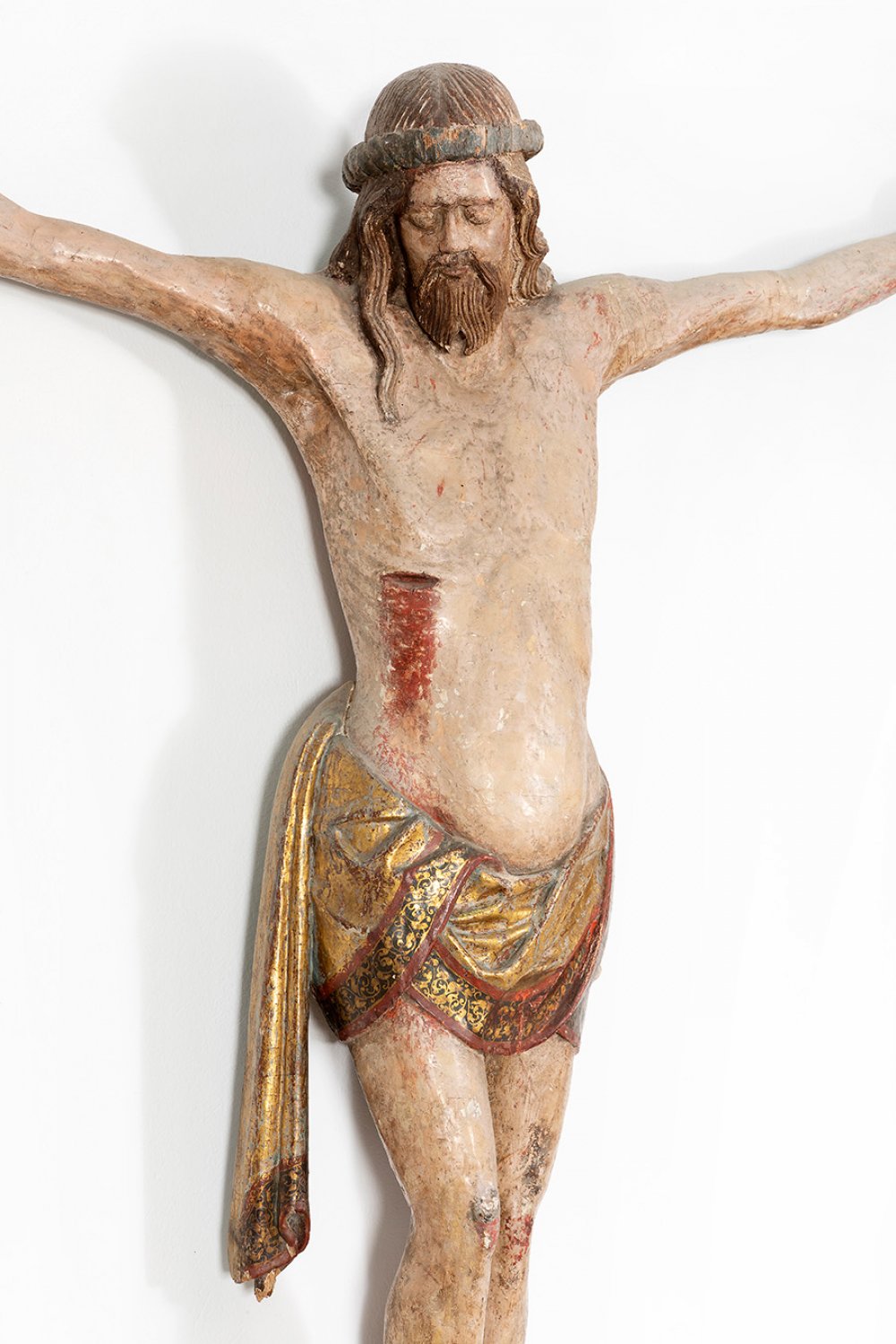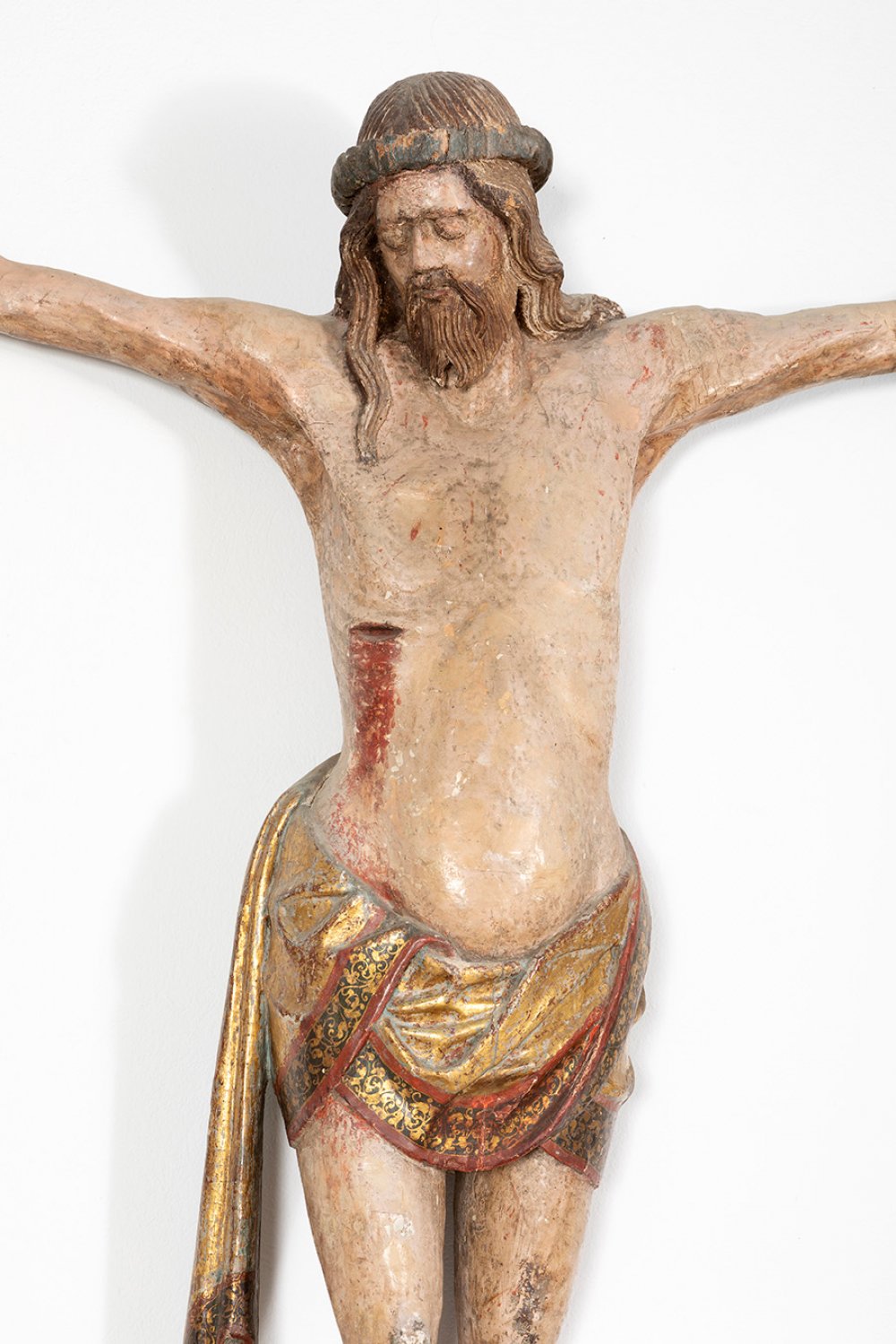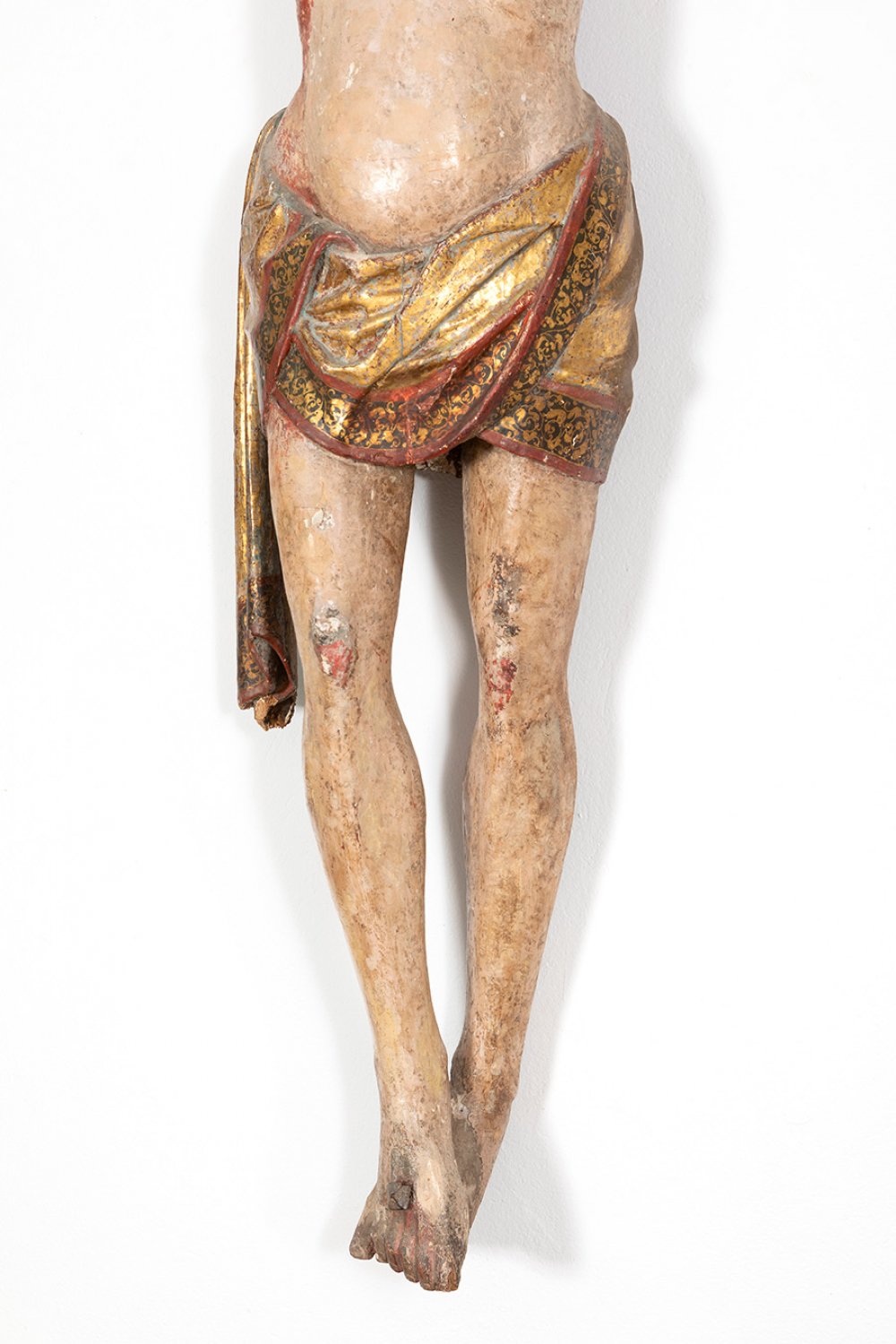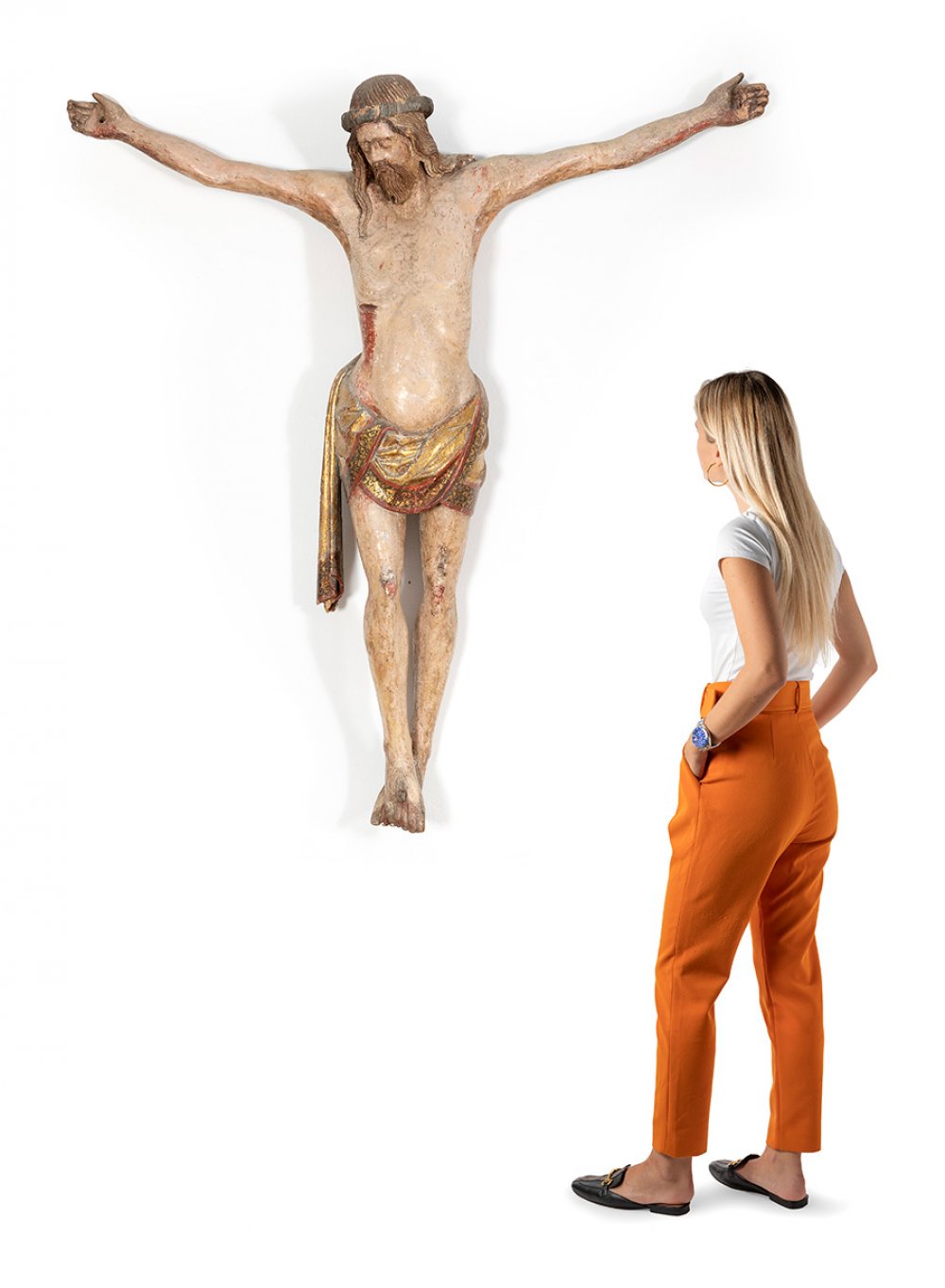14
Gothic Christ, 15th century.Carved and polychrome wood.Measurements: 154 cm (height) x 148 cm (
Carved and polychrome wood.
Measurements: 154 cm (height) x 148 cm (width).
Round figure carved in wood and polychrome, representing a crucified Christ, already dead, with closed eyelids and half-open lips. The tilted head draws a diagonal with respect to the legs slightly tilted to the opposite side, so that the body is harmonious in anatomy and proportions. There is a restrained drama in the treatment of the traces of suffering, especially in the chest with its marked ribs, and the thinness that gives a glimpse of muscles and tendons, as if the tension of pain were still palpitating in the inert body. The purity cloth is gathered at the side, favouring a play of naturalistic drapery. All these characteristics are typical of the late Gothic period: the naturalism imprinted on the canvases, which differs from the greater angularity of the early Gothic, as well as the study of chiaroscuro and the realistic intention in the anatomical description.
During the Gothic period, free-standing sculpture, independent of the architectural framework, considerably increased its repertoire, both in typology and iconography. However, the figure of Christ crucified respects the tradition of the Romanesque period, although the Christ dressed in a tunic disappears and the cloth of purity is maintained. From the Gothic period onwards, Christ was depicted dressed only in a cloth of purity. In the Romanesque it always appeared with four nails, but in the Gothic period the model of three nails became more and more frequent, with only one for the feet, as we see here. As the Gothic period progressed, the cloth of purity became shorter, until the knees were exposed.
The representation of the crucifixion has undergone an evolution parallel to the liturgical and theological variations of Catholic doctrine in which we would like to point out three milestones: at first early Christian art omitted the representation of the human figure of Christ and the crucifixion was represented by means of the "Agnus Dei", the mystical lamb carrying the cross of martyrdom. Until the 11th century Christ was represented crucified but alive and triumphant, with his eyes open, in accordance with the Byzantine rite, which did not consider the possibility of the existence of Christ's corpse. Later, under the theological consideration that the death of the Saviour was not due to an organic process but to an act of divine will, Christ is represented, as in our work, already dead with his eyes closed and his head fallen on his right shoulder, showing the sufferings of the Passion, provoking commiseration.
Crucified Crucifixions can be found in Spain as early as the 11th century, at least, and it was precisely the trend towards naturalism that was already evident in the Proto-Gothic period that led to the generalisation and popularity of the theme. Throughout the three centuries of the historical Gothic period, the theme evolved, starting from Romanesque models but introducing significant changes from the outset. Thus, the head is inclined towards the shoulder, as we see here, and the face, if Christ is alive, appears impassive, with closed or half-open eyes and a generally closed mouth. The anatomy evolves from Byzantine-type geometric schemes to an increasingly naturalistic modelling which, from the 14th century onwards, is mixed with a sense of pain and an emphasis on the pathetic, leading to distortion of the figure and often to abundant blood. The legs are placed in a forced position, the right leg on the left and the feet joined by a single nail. There is also a certain movement of external rotation, often resulting in the heel crossing in front of the opposite foot. As the style progresses, a greater lightness and movement in the composition will be appreciated, reflected mainly in the advancement of the knee, with the belly depressed and the shoulders forward, as can be seen in this piece.
Carved and polychrome wood.
Measurements: 154 cm (height) x 148 cm (width).
Round figure carved in wood and polychrome, representing a crucified Christ, already dead, with closed eyelids and half-open lips. The tilted head draws a diagonal with respect to the legs slightly tilted to the opposite side, so that the body is harmonious in anatomy and proportions. There is a restrained drama in the treatment of the traces of suffering, especially in the chest with its marked ribs, and the thinness that gives a glimpse of muscles and tendons, as if the tension of pain were still palpitating in the inert body. The purity cloth is gathered at the side, favouring a play of naturalistic drapery. All these characteristics are typical of the late Gothic period: the naturalism imprinted on the canvases, which differs from the greater angularity of the early Gothic, as well as the study of chiaroscuro and the realistic intention in the anatomical description.
During the Gothic period, free-standing sculpture, independent of the architectural framework, considerably increased its repertoire, both in typology and iconography. However, the figure of Christ crucified respects the tradition of the Romanesque period, although the Christ dressed in a tunic disappears and the cloth of purity is maintained. From the Gothic period onwards, Christ was depicted dressed only in a cloth of purity. In the Romanesque it always appeared with four nails, but in the Gothic period the model of three nails became more and more frequent, with only one for the feet, as we see here. As the Gothic period progressed, the cloth of purity became shorter, until the knees were exposed.
The representation of the crucifixion has undergone an evolution parallel to the liturgical and theological variations of Catholic doctrine in which we would like to point out three milestones: at first early Christian art omitted the representation of the human figure of Christ and the crucifixion was represented by means of the "Agnus Dei", the mystical lamb carrying the cross of martyrdom. Until the 11th century Christ was represented crucified but alive and triumphant, with his eyes open, in accordance with the Byzantine rite, which did not consider the possibility of the existence of Christ's corpse. Later, under the theological consideration that the death of the Saviour was not due to an organic process but to an act of divine will, Christ is represented, as in our work, already dead with his eyes closed and his head fallen on his right shoulder, showing the sufferings of the Passion, provoking commiseration.
Crucified Crucifixions can be found in Spain as early as the 11th century, at least, and it was precisely the trend towards naturalism that was already evident in the Proto-Gothic period that led to the generalisation and popularity of the theme. Throughout the three centuries of the historical Gothic period, the theme evolved, starting from Romanesque models but introducing significant changes from the outset. Thus, the head is inclined towards the shoulder, as we see here, and the face, if Christ is alive, appears impassive, with closed or half-open eyes and a generally closed mouth. The anatomy evolves from Byzantine-type geometric schemes to an increasingly naturalistic modelling which, from the 14th century onwards, is mixed with a sense of pain and an emphasis on the pathetic, leading to distortion of the figure and often to abundant blood. The legs are placed in a forced position, the right leg on the left and the feet joined by a single nail. There is also a certain movement of external rotation, often resulting in the heel crossing in front of the opposite foot. As the style progresses, a greater lightness and movement in the composition will be appreciated, reflected mainly in the advancement of the knee, with the belly depressed and the shoulders forward, as can be seen in this piece.
7th September - Old Masters
Sale Date(s)
Venue Address
General delivery information available from the auctioneer
Setdart offers Worldwide shipping
PICK UP IN ROOM: You can come and pick up your lots in our offices (Barcelona, Madrid or Valencia). At the moment of the withdrawal, you will be able to accept the current conditions of the lot by means of a document that you will sign.
YOU CAN SEND ANOTHER PERSON TO PICK UP: This person must present a signed authorization that you can find in our web page by accessing from BUY AT SETDART- LOGISTICS-DOWNLOAD AUTHORIZATION DOCUMENT. You can also send an e-mail with the requested data in AUTHORIZATION DOCUMENT to admin@setdart.com
Important Information
25% buyer´s premium
21% buyer´s premium at www.setdart.com
Terms & Conditions
The maximum period to pay the lots is 7 working days. You can pay either via bank transfer or with credit card through our platform www.setdart.com (we only accept VISA or Mastercard).
BUYER´S PREMIUM: 22% Hammer price + 21% VAT from the buyer´s premium
If your piece has more than 100 years, our Ministry of Culture requires an export certificate in order for the piece to leave the country. Note that if the piece goes inside the EU, there is no cost for the export certificate. If the piece goes outside the EU, there is a cost for the export certificate. You can find more information in our Ministry of Culture website: https://www.culturaydeporte.gob.es/en/cultura/patrimonio/exportacionimportacion/exportacion/tasas.html
INQUIRIES: admin@setdart.com
Setdart guides you through the entire process, from the time of award to the day you receive your lot. Our logistics team will be happy to manage your transport, and will advise you on the best shipping method with professionals from the sector used to handling works of art and jewelry.
WE OFFER WORLDWIDE DOOR TO DOOR SHIPPING
PICK UP IN ROOM: You can come and pick up your lots in our offices. At the moment of the withdrawal, you will be able to accept the current conditions of the lot by means of a document that you will sign.
YOU CAN SEND ANOTHER PERSON TO PICK UP: This person must present a signed authorization that you can find in our web page by accessing from BUY AT SETDART-LOGISTICS-DOWNLOAD AUTHORIZATION DOCUMENT. You can also send an e-mail with the requested data in AUTHORIZATION DOCUMENT to admin@setdart.com
SETDART IS NOT RESPONSIBLE FOR THE STATE OF THE PARTS ONCE THEY LEAVE OUR FACILITIES. MRW SHIPMENTS: Once the payment is made, your lot will be packed for shipment, the logistics department will send you an e-mail notifying you of the day it leaves our warehouse, changes of address cannot be made after receiving this e-mail.
INSURANCE INCIDENTS: Coverage for the value of the auction up to 3000 ? per shipment, if the value of the auction is higher, Setdart will send you a quote including the additional insurance. The insurance company WILL NOT BE RESPONSIBLE FOR THE SHIPMENT THAT EXCEEDS THAT AMOUNT AND IS NOT FULLY INSURED. MRW INCIDENTS: Maximum notification 48 hours after receipt, after which the insurance company WILL NOT BE RESPONSIBLE AND NO CLAIMS WILL BE ACCEPTED.
E-MAIL LOGISTICS: logistica@setdart.com
PICK UP YOUR MESSAGES: You can send your own messaging, prior notice via e-mail that your shipment is ready, please note 3 or 4 days in advance. This type of shipment is packaged so Setdart will provide you with a quote.
EXPENSES FOR STORAGE: We inform you that if the purchased lot is not picked up within a month, you will be charged 30€ per week per lot. Setdart Online S.L., owner of the web site "setdart.com", "setdart.net" and "setdart.org", acts as a company of Spanish nationality inscribed in the Volume 36955, sheet 182, page B-293056 of the Mercantile Registry, with registered office at Calle Aragó


















